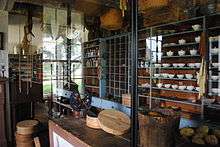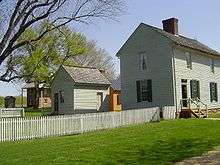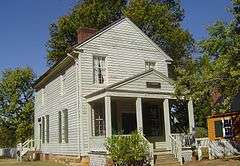Plunkett-Meeks Store
|
Plunkett-Meeks Store | |
|
Plunkett-Meeks Store | |
| Location | Appomattox County, Virginia |
|---|---|
| Nearest city | Appomattox, Virginia |
| Built | 1852 |
| Architect | John H. Plunkett |
| Visitation | 185,443[1] (2009) |
| Part of | Appomattox Court House National Historical Park (#66000827[2]) |
| Added to NRHP | October 15, 1966 |

The Plunkett-Meeks Store is a structure within the Appomattox Court House National Historical Park.[3] It was registered in the National Park Service's database of Official Structures on June 26, 1989.[4]
History
The Plunkett-Meeks Store was built by John H. Plunkett in 1852 and later in the early 1860s purchased by Albert Francis Meeks, the village storekeeper, postmaster, and druggest.[5] It was the social center of village life at what was then known as Clover Hill, Virginia. It is a major part of the historical setting of the Appomattox Court House National Historical Park. It represents the participation of the federal government in the preservation and commemoration of historically significant events.[4]
Meek's son, known as Lafayette, died of typhoid fever while serving the Confederate army. He died when only nineteen years old and is buried behind the store. The store has been used from time to time as a private residence and at one time as the Presbyterian Church parsonage.[5]
Historical significance
The building structure is important because it embodies the distinctive characteristics of a type, period, and method of construction in the mid-nineteenth century in rural Virginia. The buildings and resources of Plunkett-Meeks Store and storage building constitute a complete landscape typical of both a county government seat in Piedmont Virginia and of a farming community in the mid-nineteenth century in rural Virginia. It has historical meaning to the Appomattox Court House National Historical Park by virtue of its association with the site of General Robert E. Lee's surrender to General Ulysses S. Grant. The Plunkett-Meeks Store and storehouse building was registered and documented in the National Register of Historic Places on June 26, 1989.[4]
Description
The Plunkett-Meeks Store is a two-story gray building with a basement and attic. It has a deep pointed rubble fieldstone raised foundation and sheathed in weatherboards with a gable wood shingle roof. The wood shingles are round-butt. The building is about twenty feet wide by thirty six feet deep. The north porch is five feet by sixteen feet. The east end of the Plunkett-Meeks Store has an eight-foot by eighteen-foot temple form entry porch on brick piers. The paried four-panel entry doors are flanked by 9/9 double hanging windows. The second floor has 6/9 double hanging windows.[6]
The Plunkett-Meeks Store is enclosed at the second floor approached by a set of open riser stairs. The first floor is furnished and interpreted as a General Store and post office. The second floor is used for offices of the park. The structure was restored in 1959 and again in 1983. The structure was altered some in 1874.[6]

Plunkett-Meeks storage building
The one story frame building was built by John Plunkett around 1850. The original orientation of the Plunkett-Meeks storage building is not known. It may have had doors facing the main village street and the Plunkett-Meeks Store and may have been located on the fence line at the southwest corner of the property.[6]
The one story gray structure is sixteen feet wide by fourteen feet deep. It has a gable roof and deeply pointed, rough-cut, fieldstone piers. The structure is sheathed in weatherboards of about five and a half inches. They are covered by a clipped-corner wood shingle roof. The west and south entrances have four panel doors. The north side does not have any openings. The sash windows are 6/6 double hanging.[6]
Its present location is next to the Plunkett-Meeks Store and behind the Woodson Law office, although this probably was not its original location when built originally by John Plunkett in 1850. The building was altered in 1874. It was restored by the National Park Service in 1959 and 1983.[6]
Footnotes
| Wikimedia Commons has media related to Appomattox Court House National Historical Park. |
- ↑ "NPS Annual Recreation Visits Report". National Park Service.
- ↑ National Park Service (2009-03-13). "National Register Information System". National Register of Historic Places. National Park Service.
- ↑ Marvel, A place called Appomattox, has an extensive bibliography (pp. 369-383) which lists manuscript collections, private papers and letters that were consulted, as well as, newspapers, government documents, and other published monographs that were used in his research of Appomattox.
- 1 2 3 "Plunkett-Meeks Store". Retrieved 2009-01-21.
- 1 2 Gutek, p. 299
- 1 2 3 4 5 Jon B. Montgomery; Reed Engle & Clifford Tobias (May 8, 1989). "National Register of Historic Places Registration: Appomattox Court House / Appomattox Court House National Historical Park (version from Virginia Department of Historic Resources, including maps)" (pdf). National Park Service. and Accompanying 12 photos, undated (version from Federal website) (32 KB) and one photo, undated, at Virginia DHR
Sources
- Bradford, Ned, Battles and Leaders of the Civil War, Plume, 1989
- Catton, Bruce, A Stillness at Appomattox, Doubleday 1953, Library of Congress # 53-9982, ISBN 0-385-04451-8
- Catton, Bruce, This Hallowed Ground, Doubleday 1953, Library of Congress # 56-5960
- Chaffin, Tom, 2006. Sea of Gray: The Around-the-World Odyssey of the Confederate Raider Shenandoah, Hill and Wang/Farrar, Straus and Giroux,.
- Davis, Burke, The Civil War: Strange & Fascinating Facts, Wings Books, 1960 & 1982, ISBN 0-517-37151-0
- Davis, Burke, To Appomattox - Nine April Days, 1865, Eastern Acorn Press, 1992, ISBN 0-915992-17-5
- Featherston, Nathaniel Ragland, Appomattox County History and Genealogy, Genealogical Publishing Company, 1998, ISBN 0-8063-4760-0
- Gutek, Patricia, Plantations and Outdoor Museums in America's Historic South, University of South Carolina Press, 1996, ISBN 1-57003-071-5
- Hosmer, Charles Bridgham, Preservation Comes of Age: From Williamsburg to the National Trust, 1926-1949, Preservation Press, National Trust for Historic Preservation in the United States by the University Press of Virginia, 1981
- Ivy, Emma Plunkett, Ten Thousand Plunketts, Peachtree Printing, 1974
- Kaiser, Harvey H., The National Park Architecture Sourcebook, Princeton Architectural Press, 2008, ISBN 1-56898-742-0
- Kennedy, Frances H., The Civil War Battlefield Guide, Houghton Mifflin Company, 1990, ISBN 0-395-52282-X
- Korn, Jerry et al., The Civil War, Pursuit to Appomattox, The Last Battles, Time-Life Books, 1987, ISBN 0-8094-4788-6
- Marvel, William, A Place Called Appomattox, UNC Press, 2000, ISBN 0-8078-2568-9
- Marvel, William, Lee's Last Retreat, UNC Press, 2006, ISBN 0-8078-5703-3
- McPherson, James M., Battle Cry of Freedom, Oxford University Press, 1988,
- National Park Service, Appomattox Court House: Appomattox Court House National Historical Park, Virginia, U.S. Dept. of the Interior, 2002, ISBN 0-912627-70-0
- Tidwell, William A., April '65: Confederate Covert Action in the American Civil War, Kent State University Press, 1995, ISBN 0-87338-515-2
- Weigley, Russel F., A Great Civil War: A Military and Political History, 1861-1865, Indiana University Press, 2000, ISBN 0-253-33738-0
